Overview
In the realm of software development, coding challenges are a common hurdle that developers must navigate. How can these challenges be effectively addressed? Enter Kodezi, a tool designed to streamline the coding process. Kodezi automates code maintenance, enhances bug detection, and offers real-time insights, which are essential for improving efficiency.
Utilizing Kodezi not only simplifies the development process but also significantly boosts productivity and code quality. Imagine a scenario where your team can detect bugs before they escalate, or where code maintenance is automated, freeing up valuable time for innovation. This is the promise that Kodezi brings to development teams.
Furthermore, the benefits of using Kodezi extend beyond mere efficiency. By adopting this tool, developers can focus more on creative problem-solving rather than getting bogged down by routine tasks. This leads to higher quality code and a more productive development environment.
Are you ready to explore the tools that can transform your coding practices? Discover how Kodezi and similar applications can elevate your software development processes. With the right tools at your disposal, you can turn challenges into opportunities for growth.
Introduction
In the dynamic realm of software development, developers face persistent challenges that hinder coding efficiency. How can these challenges be effectively addressed? Enter Kodezi—an innovative solution that streamlines coding processes and tackles the complexities of bug detection and performance optimization. As organizations strive for enhanced productivity and reliability, Kodezi stands out by offering unique features designed to elevate performance and ensure seamless operations. This article explores ten essential AI application monitoring tools, including Kodezi, that promise to boost efficiency and transform coding practices, showcasing their specific benefits and capabilities.
Kodezi | Professional OpenAPI Specification Generator - AI Dev-Tool: Automate Code Maintenance and Monitoring
In the ever-evolving landscape of software development, coding challenges can significantly hinder productivity. This is where Kodezi comes into play, serving as a professional OpenAPI specification generator that automates code maintenance and includes AI application monitoring. By seamlessly integrating with existing development environments, Kodezi not only enhances productivity but also mitigates technical debt.
What if you could detect and resolve bugs instantly? Kodezi's autonomous capabilities allow it to fix performance bottlenecks and improve code formatting without any manual intervention. This proactive approach addresses the issues of code degradation, which can greatly impede software development productivity. As a result, Kodezi becomes an essential tool for engineering teams striving for efficiency and long-term maintainability.
Furthermore, as organizations increasingly adopt autonomous codebase management solutions, Kodezi exemplifies the latest trends in the industry. It equips teams with the necessary tools to thrive in a complex development landscape. With features such as automated builds and testing, Kodezi ensures that code quality improves with every release. This makes it a versatile solution for developers at all levels, enhancing both productivity and code quality.
Are you ready to elevate your coding practices? Explore the tools available on the Kodezi platform and experience the difference for yourself.
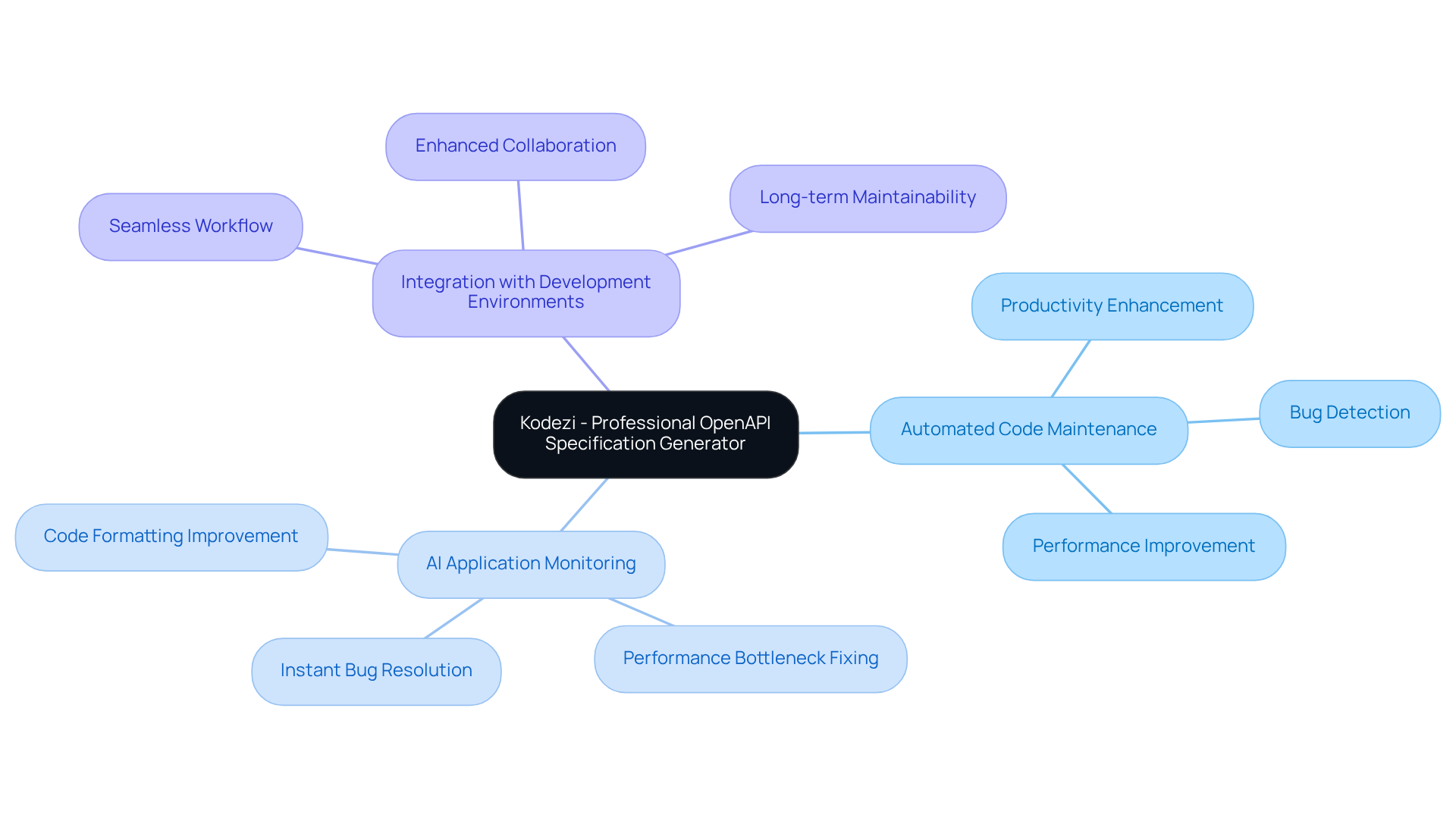
New Relic AI Monitoring: Achieve Real-Time Visibility for Optimal Performance
Coding challenges can be overwhelming for developers. However, Kodezi's automated code debugging offers a solution by providing strong real-time insights into software functionality. This enables teams to quickly recognize and resolve problems, ensuring smoother operations. With AI application monitoring, developers gain a deeper understanding of user interactions and system behavior, which is crucial for maintaining efficiency.
Furthermore, statistics suggest that adopting AI application monitoring can decrease delays by as much as 58%, particularly in supply chain efficiency. This highlights the substantial impact that Kodezi can have on overall results. By employing this tool, teams can proactively oversee efficiency indicators through AI application monitoring, enhance user experiences, and ensure their software remains responsive and dependable.
In addition, the full visibility provided by Kodezi allows teams to resolve efficiency bottlenecks, identify security concerns, incorporate exception handling, and improve code formatting in any section of their codebase in moments. This further boosts software efficiency and productivity.
To optimize the advantages of Kodezi, teams should frequently assess metrics and adjust their strategies accordingly. Are you ready to explore the tools available on the Kodezi platform and transform your coding practices?
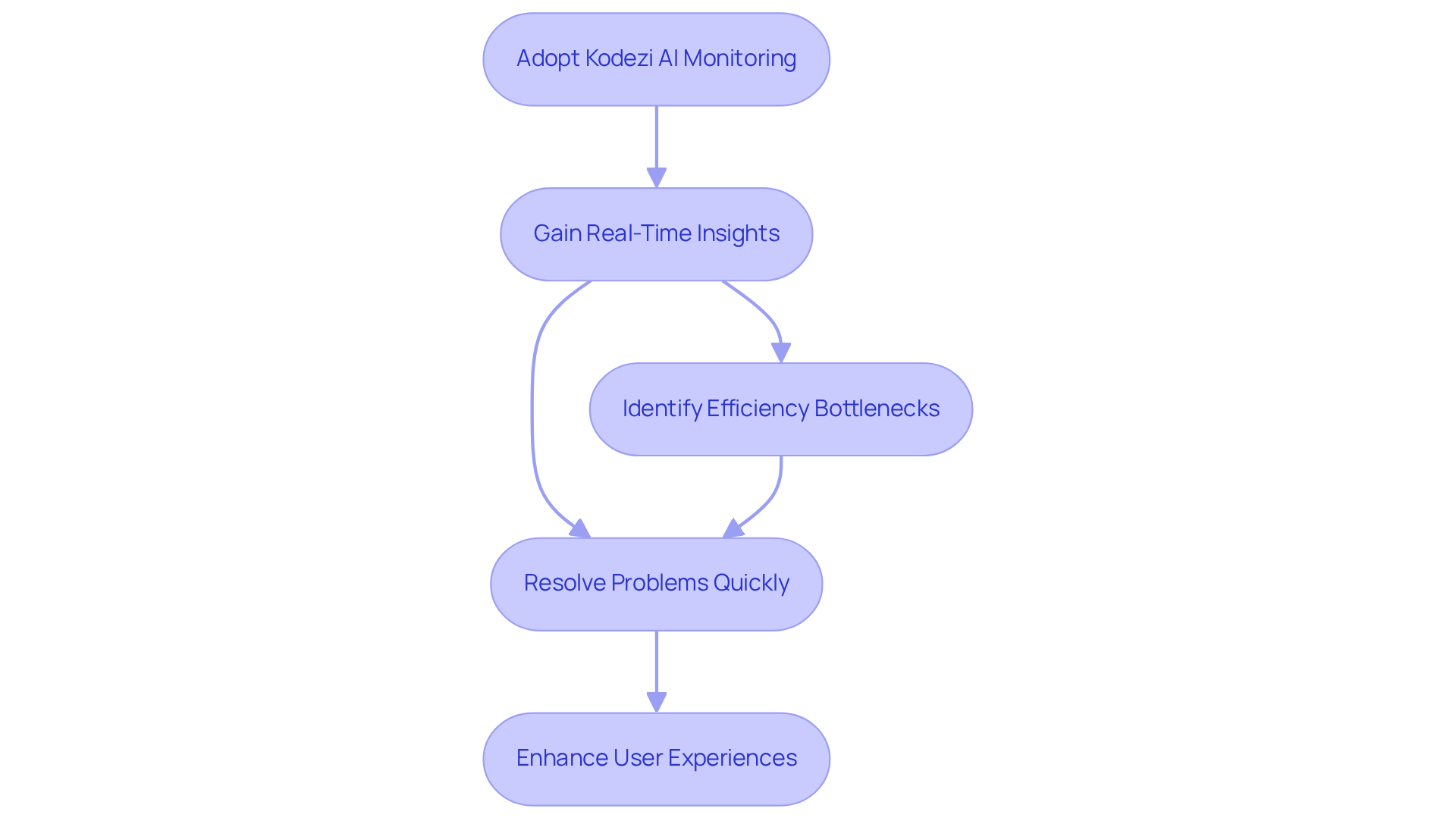
Fiddler AI Observability: Automatically Detect and Resolve Bugs in Applications
In today's fast-paced software environment, developers face significant challenges in identifying and resolving bugs efficiently. Fiddler AI Observability addresses these challenges by providing a robust platform for AI application monitoring that enables the automatic identification and resolution of bugs within software. Utilizing advanced algorithms, AI application monitoring consistently tracks software efficiency and user interactions, enabling teams to recognize and resolve issues before they impact users.
This proactive strategy not only enhances software quality but also significantly reduces debugging time with the help of AI application monitoring. As a result, developers can focus on innovation rather than firefighting. Organizations that utilize AI application monitoring and automated bug resolution tools often experience a marked decrease in average bug resolution times, with many achieving resolutions for critical issues in under 24 hours.
Such efficiency boosts customer satisfaction and fosters a culture of continuous improvement within development teams. Furthermore, as noted by industry leaders, the shift towards automated solutions is essential for maintaining a competitive advantage. Are you ready to explore how Fiddler AI Observability can transform your debugging process and elevate your development practices?
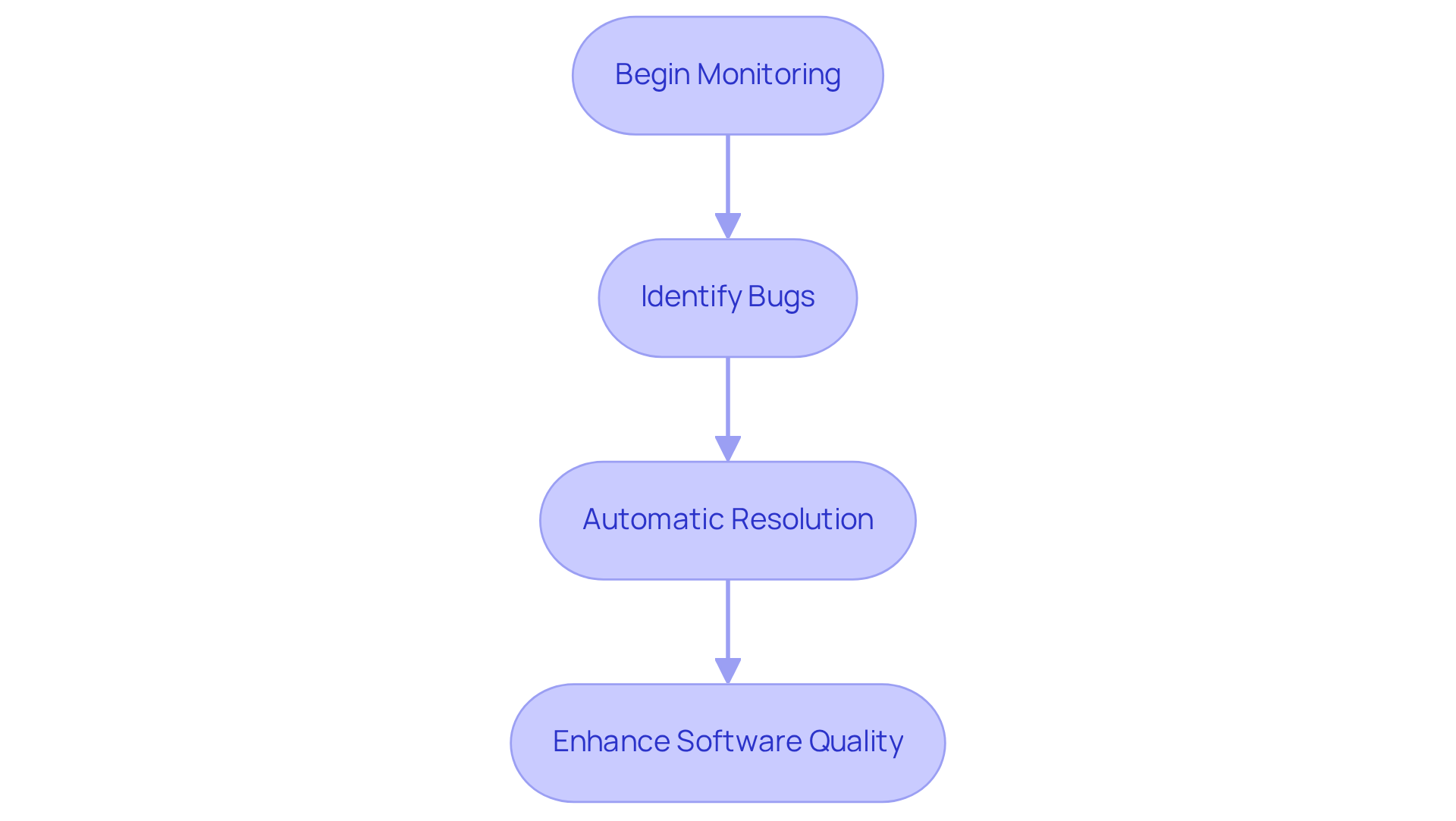
Cribl AI Monitoring: Ensure Continuous Monitoring for Adaptive Performance
Cribl's AI application monitoring provides essential ongoing supervision of software functionality, adapting dynamically to shifts in user behavior and system requirements. How can organizations ensure they maintain optimal performance? By delivering real-time insights and alerts, Cribl supports AI application monitoring, empowering teams to sustain peak output levels and swiftly address potential issues. This adaptability is vital for organizations aiming to deliver seamless user experiences in ever-evolving environments.
Furthermore, specialists emphasize that AI application monitoring enables the continuous oversight of systems, which not only enhances operational efficiency but also significantly boosts user satisfaction, marking it as a critical strategy for success in 2025. Real-world applications of AI application monitoring demonstrate that organizations can proactively respond to challenges, ensuring uninterrupted and engaging user experiences.
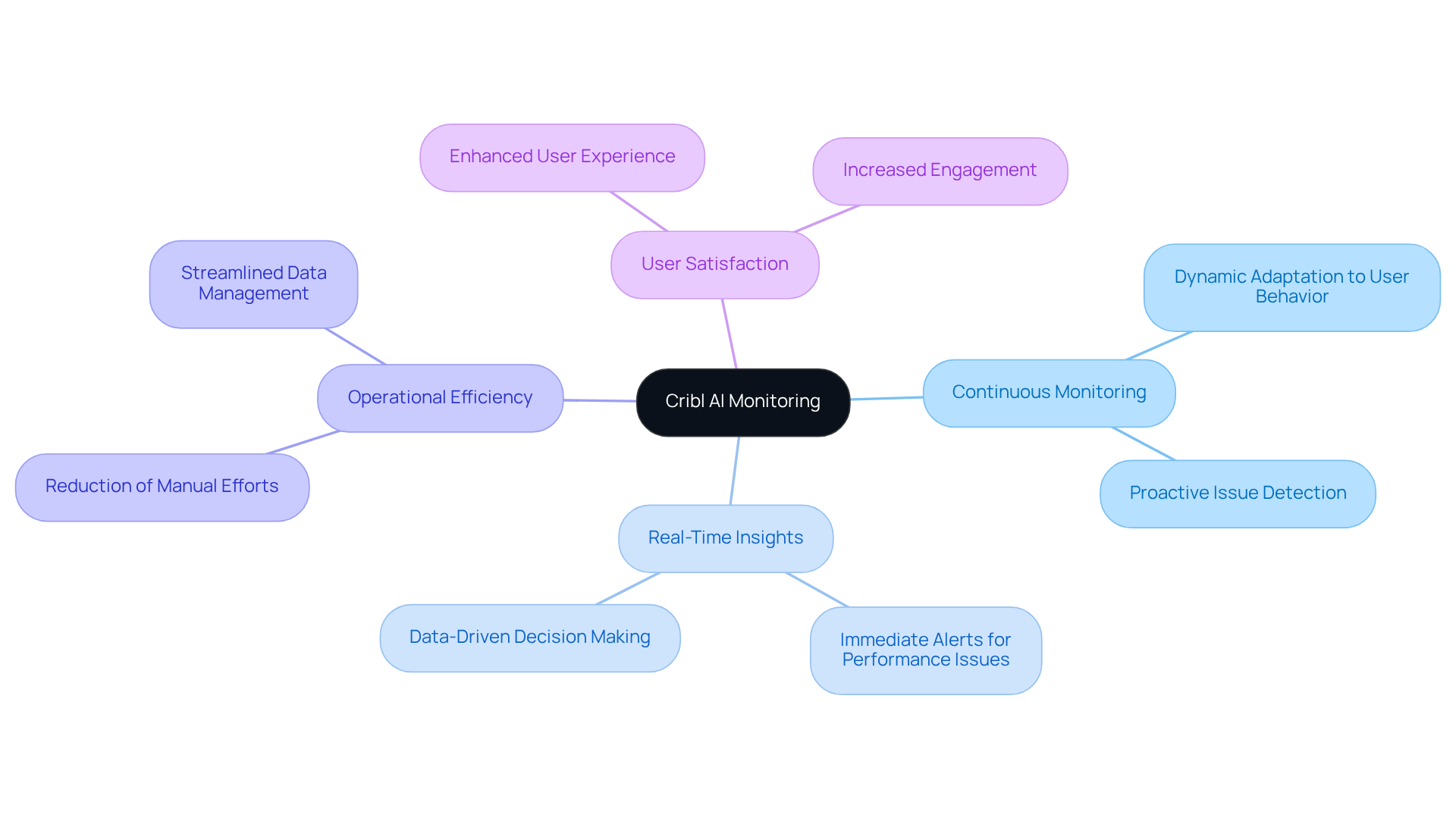
Azure AI Foundry: Optimize Resource Usage with Intelligent Monitoring
Intelligent monitoring tools are transforming the landscape of AI application monitoring, as exemplified by Azure AI Foundry. These tools optimize resource usage by analyzing effectiveness indicators and usage trends, enabling organizations to allocate resources more efficiently. This not only reduces expenses but also maintains high quality, a crucial balance for organizations aiming to scale their AI initiatives without overspending.
For instance, the U.S. Army Corps of Engineers realized annual savings of $100 million through AI application monitoring, highlighting the substantial impact of these tools.
As we approach 2025, the integration of AI application monitoring tools will be essential for tech companies striving to streamline operations and maximize their ROI from AI investments.
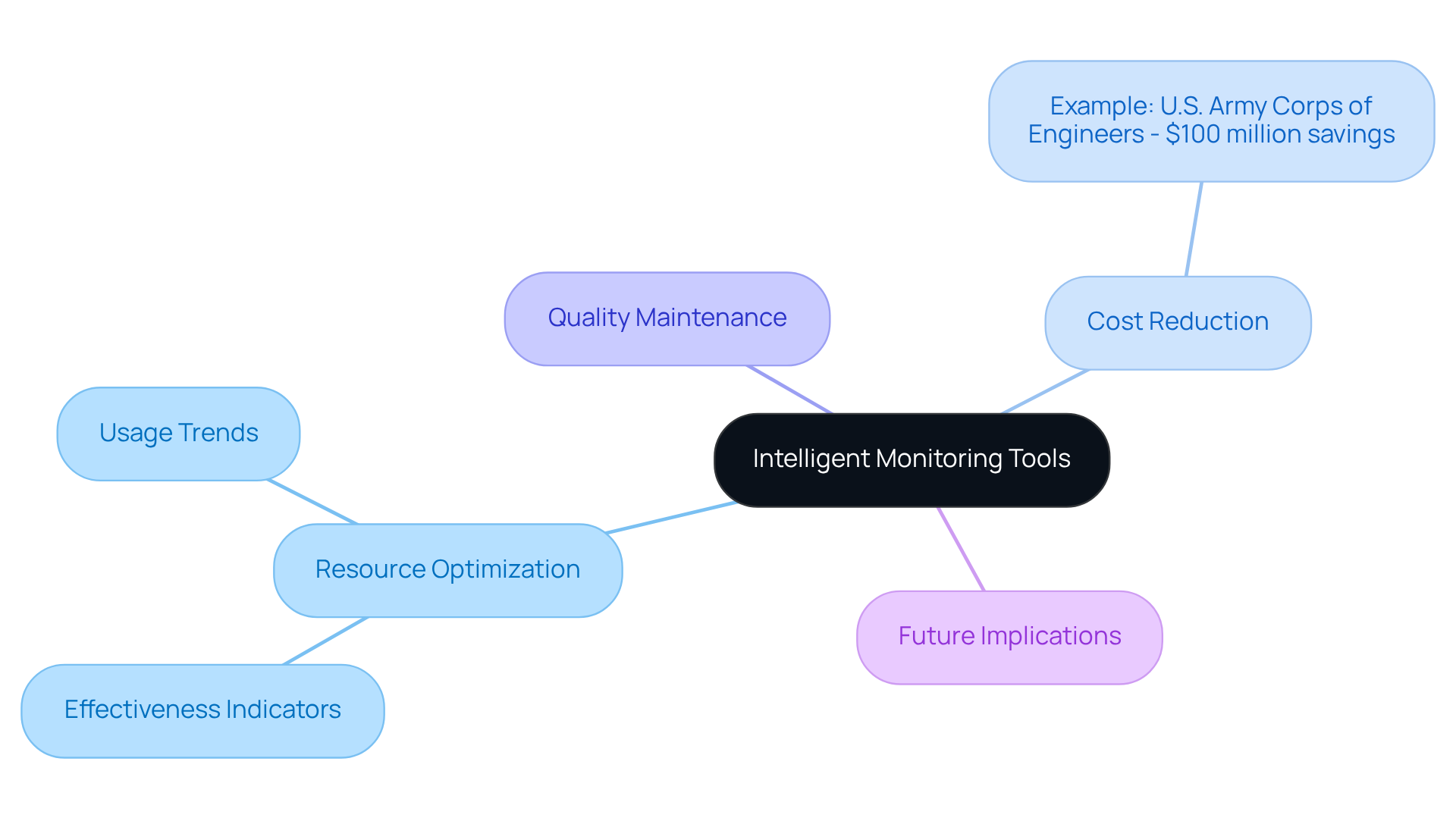
AI Model Monitoring: Track and Enhance Model Performance Effectively
AI application monitoring is essential for ensuring that machine learning systems consistently deliver accurate and reliable results. By continuously tracking key metrics such as accuracy, precision, and recall, teams can quickly identify shifts in effectiveness and implement necessary adjustments. This proactive approach not only protects the efficiency of AI models in production environments but also enhances their overall reliability with effective AI application monitoring.
For instance, organizations that prioritize model monitoring have reported significant improvements, with some achieving up to a 20% increase in precision over time. Furthermore, expert opinions highlight that regular evaluation of machine learning metrics is vital for adapting to evolving data landscapes and user needs.
As we look ahead to 2025, the focus on robust AI application monitoring practices will be critical, as it directly impacts the effectiveness and reliability of AI systems across various sectors.
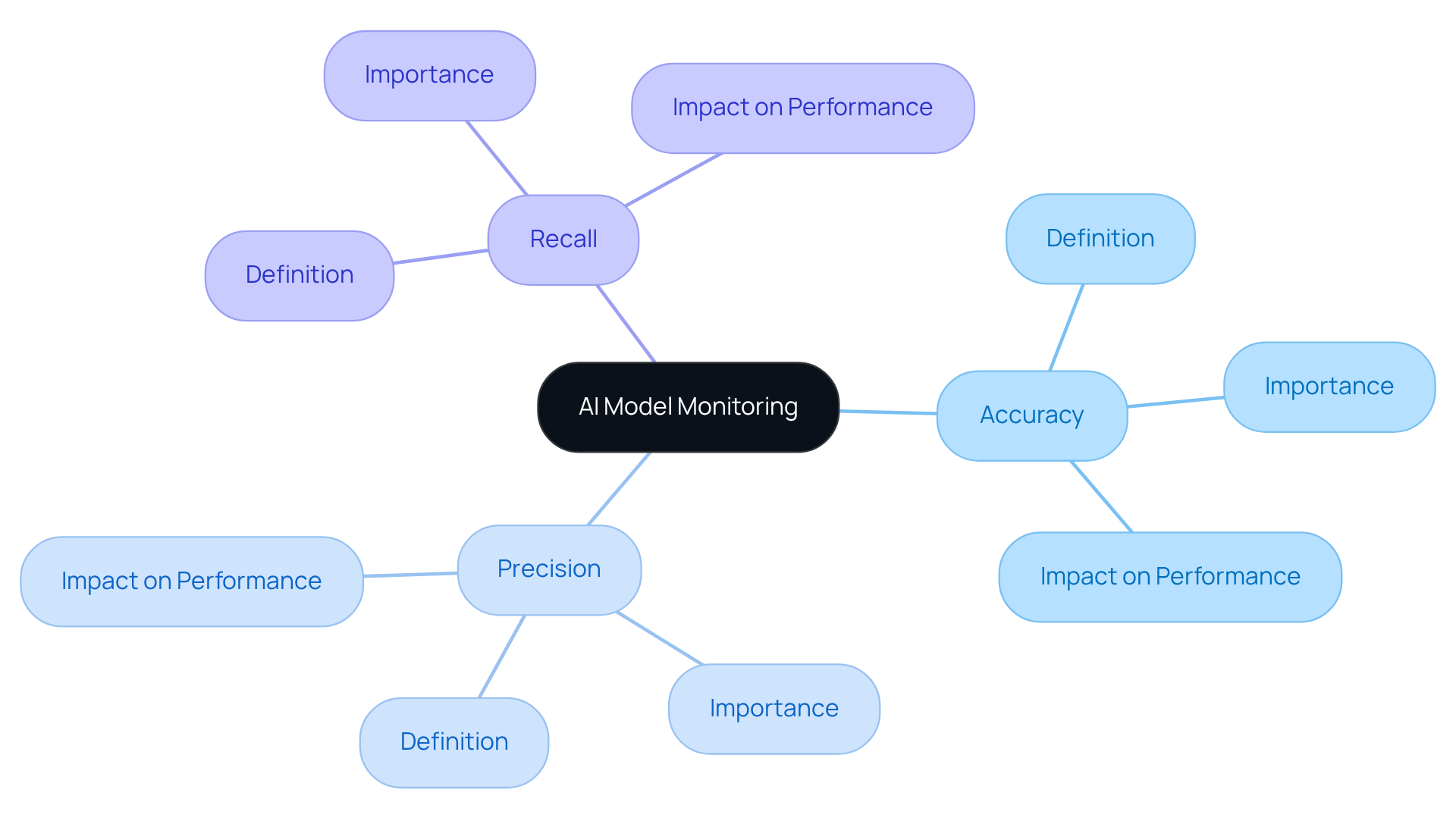
AI Monitoring for APIs: Maintain Integrity and Performance Across Services
Developers often encounter significant challenges in maintaining the integrity and performance of application programming interfaces (APIs). These challenges can manifest as latency, errors, and security vulnerabilities, which can severely impact user experience. Kodezi addresses these pain points effectively through its automated code debugging feature. By continuously implementing AI application monitoring of API calls and responses, Kodezi allows developers to instantly identify and rectify codebase issues, ensuring that services operate seamlessly together.
Moreover, this oversight enhances overall user experience while optimizing performance and ensuring compliance with the latest security best practices. Imagine the productivity gains when developers can focus on creating rather than troubleshooting. With Kodezi, teams can improve code quality and streamline their processes, making it an invaluable tool in any developer's arsenal.
In addition, Kodezi’s features not only resolve existing issues but also prevent future complications, fostering a more robust development environment. Are you ready to elevate your coding practices? Explore the tools available on the Kodezi platform and experience the difference for yourself.
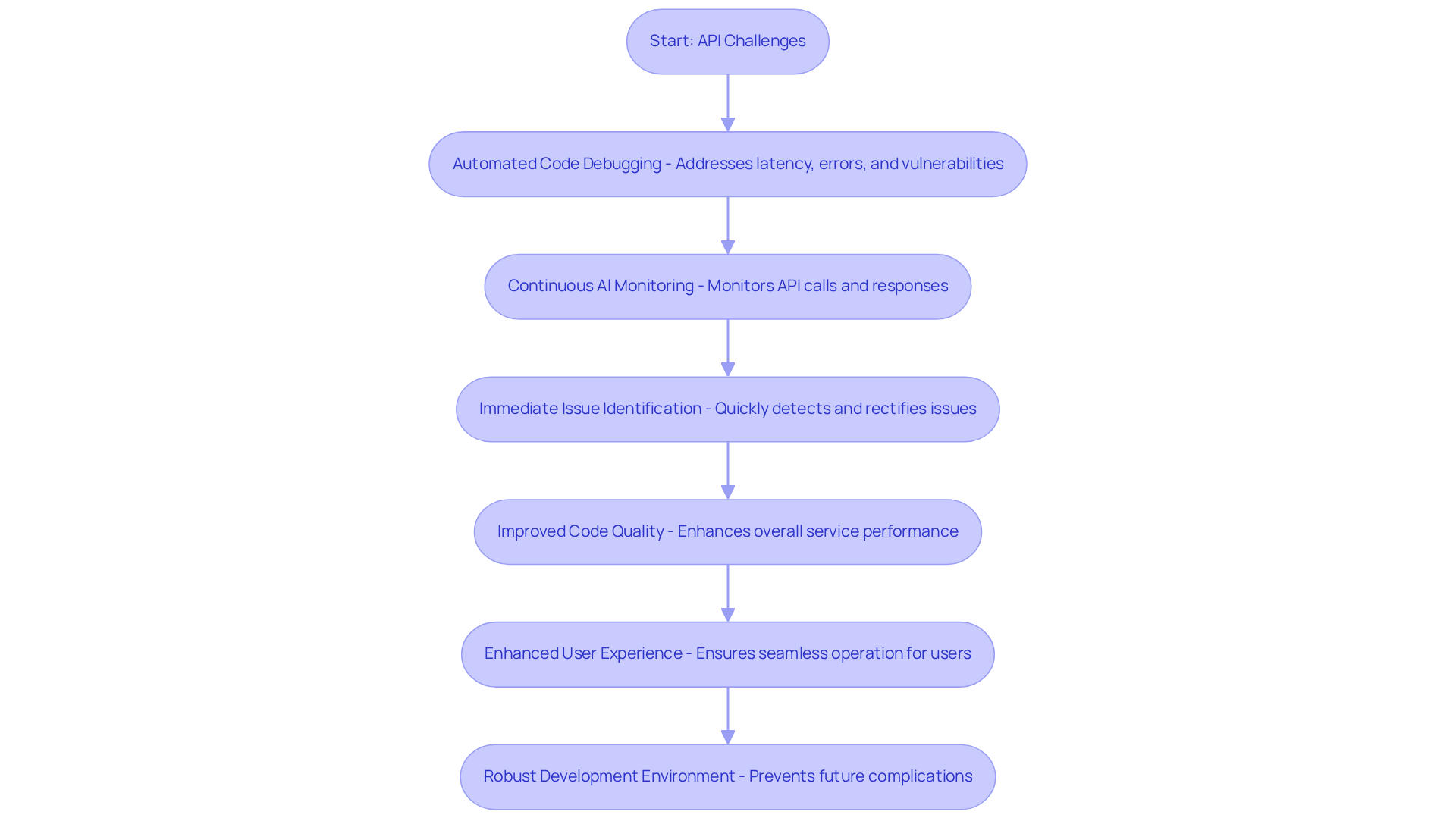
Data Input/Output Validation: Ensure Accuracy in AI Applications
Data Input/Output Validation: Ensure Accuracy in AI Applications
Data input/output validation is crucial for maintaining the accuracy and integrity of data in AI applications. Have you ever faced challenges with data quality? By implementing validation checks at various stages of data processing, teams can effectively prevent errors and inconsistencies that may lead to incorrect outputs. For instance, organizations like PepsiCo utilize automated systems to flag data quality issues, ensuring that minor discrepancies are addressed before they escalate into significant problems. This proactive approach not only enhances the reliability of AI outputs but also fosters trust in AI application monitoring systems that rely on them.
Furthermore, incorporating automated debugging features can significantly enhance the data validation process. By swiftly recognizing and resolving codebase problems, companies ensure that the data provided to AI models is precise and pertinent. This automated debugging capability complements the validation checks, allowing teams to maintain high data quality and integrity.
Expert opinions underscore the necessity of rigorous validation processes. As noted by industry leaders, the integration of human oversight in automated validation systems can significantly improve data quality. This hybrid approach allows for the identification of complex issues that automated systems might overlook, ensuring that the data fed into AI models is both accurate and relevant.
In addition, as we look ahead to 2025, the emphasis on data accuracy will only intensify as organizations increasingly rely on AI for critical decision-making. The implementation of robust input/output validation methods, alongside Kodezi's automated debugging features, will be essential for effective AI application monitoring to ensure that AI systems deliver trustworthy results. By consistently verifying data against recognized standards and utilizing methods like back-testing, organizations can improve the effectiveness of their AI application monitoring, ultimately leading to better outcomes and reduced risks associated with erroneous data.
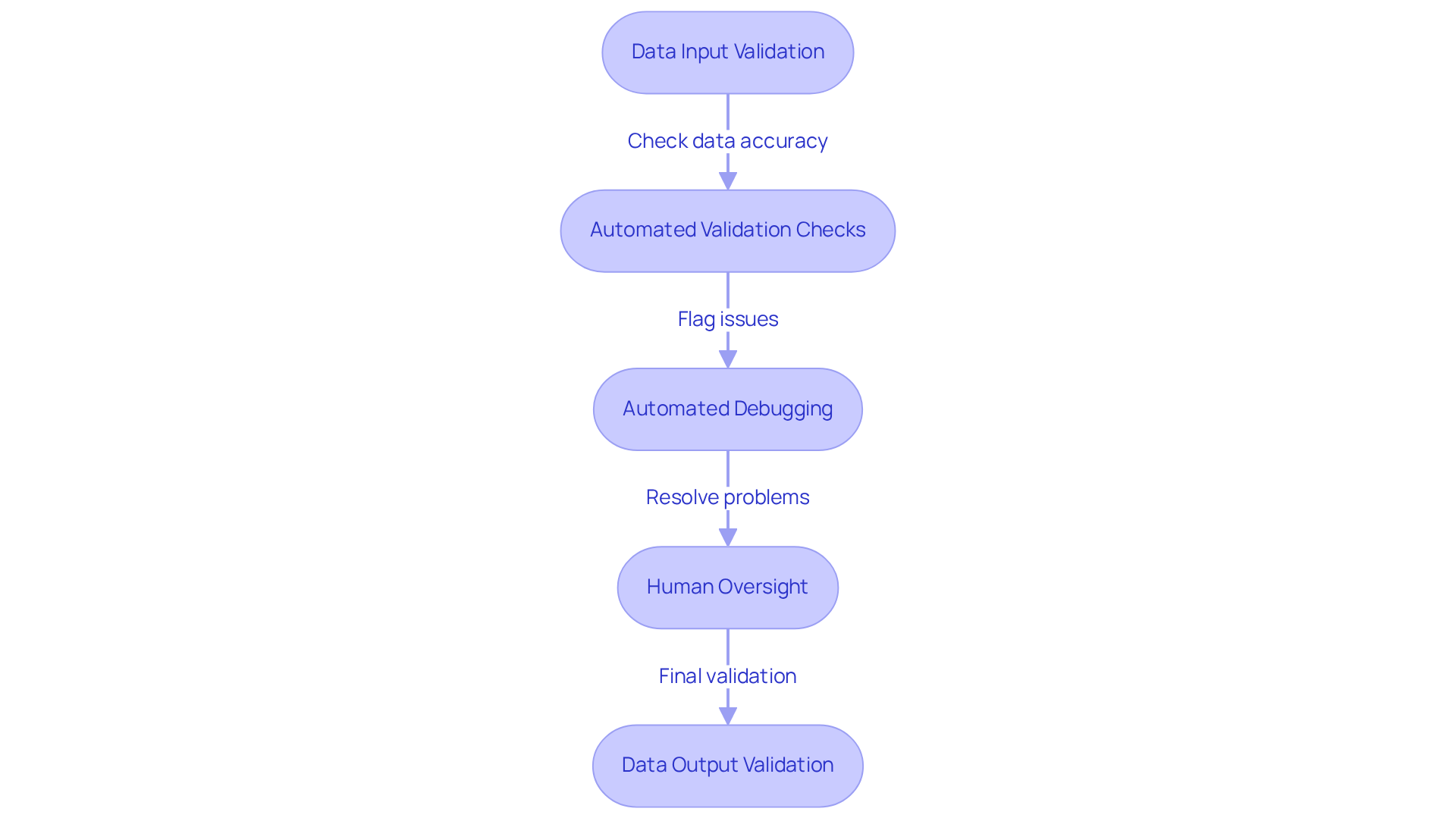
Cost Tracking and Optimization: Manage Budgets While Enhancing Performance
AI application monitoring is essential for cost tracking and optimization, helping organizations manage expenses related to AI initiatives while adhering to budgets and maximizing performance. By analyzing spending patterns and identifying areas for cost reduction, organizations can enhance their AI capabilities without overspending. For instance, implementing tagging and logging of usage data can provide a clearer understanding of which features or groups drive costs, potentially resulting in 10-20% savings as groups self-correct their usage patterns. As one industry leader noted, "You can't optimize what you can't measure, and most teams are flying blind when it comes to understanding which agent behaviors are draining their budgets." Moreover, utilizing specialized agents for specific tasks can yield better results at lower costs compared to general-purpose models, showcasing the effectiveness of targeted AI solutions.
Industry leaders emphasize the necessity of smart memory compression and efficient resource allocation. For example, leveraging spot or preemptible instances for non-urgent jobs can reduce compute costs by up to 70%. Furthermore, adopting batch inference techniques allows multiple AI requests to run simultaneously, enhancing throughput and minimizing GPU underutilization, which can lead to a threefold improvement in efficiency.
Effective budget management directly influences the success rates of projects involving AI application monitoring. More than 90% of CIOs have indicated that managing costs limits their ability to derive value from AI for their enterprises. By prioritizing cost optimization strategies, organizations can ensure that their AI application monitoring initiatives not only remain within budget but also deliver significant value. As we approach 2025, the focus on budget management will be crucial for enhancing AI capabilities while navigating the challenges posed by advancing technologies.
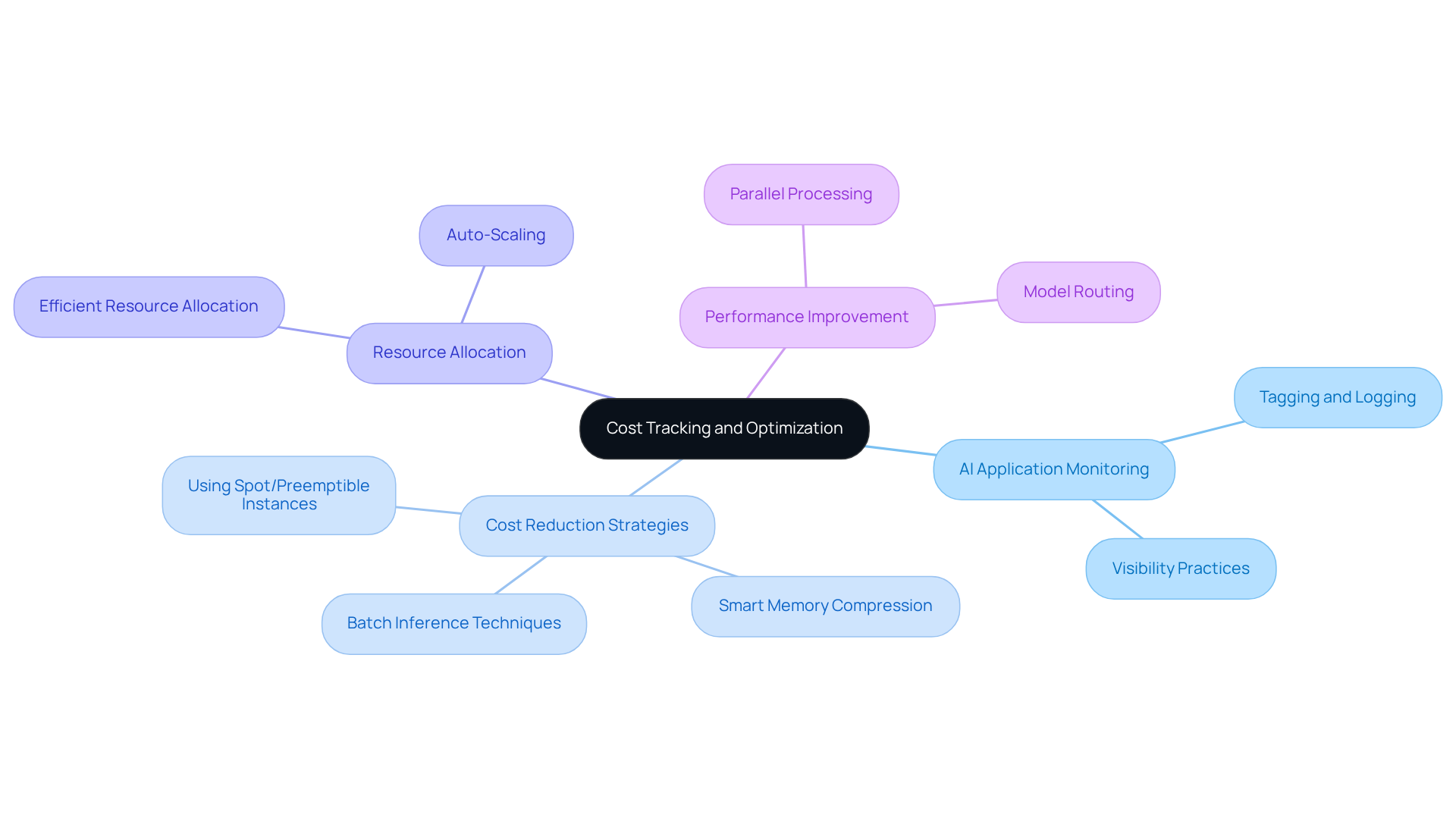
Emerging Trends in AI Monitoring: Stay Ahead in a Rapidly Evolving Landscape
Emerging trends in AI application monitoring reveal significant advancements in predictive analytics, automated anomaly detection, and deeper integration with DevOps practices. Have you noticed how quickly the landscape is changing? Recent statistics show that the adoption of predictive analytics among business leaders has surged from 55% to 75% in just one year, underscoring its growing importance in AI systems. For instance, AI-driven predictive analytics tools enhance system uptime and reduce maintenance costs by identifying performance degradation before it impacts operations.
Furthermore, real-world applications of predictive analytics in AI application monitoring are evident in tools that leverage machine learning algorithms to analyze historical and real-time data. This proactive issue resolution capability minimizes downtime and strengthens cybersecurity defenses by detecting unusual behavior in server activity. Automated code debugging tools, like those provided by various platforms, are crucial in this landscape. They enable developers to instantly identify and resolve codebase issues, ensuring adherence to the latest security best practices and coding standards. Experts emphasize that the shift from reactive to proactive AI application monitoring is revolutionizing how organizations manage their digital infrastructure, with AI models capable of detecting deviations from normal behavior and recommending solutions.
In addition, as organizations navigate this rapidly evolving landscape, staying ahead of these trends is crucial for maintaining a competitive edge. Therefore, consider integrating predictive analytics and automated debugging, particularly through Kodezi's innovative tools, into your monitoring systems. This integration enhances operational efficiency and ensures that AI systems remain robust, efficient, and adaptable to future challenges. Are you ready to explore how Kodezi can transform your coding practices and improve productivity?
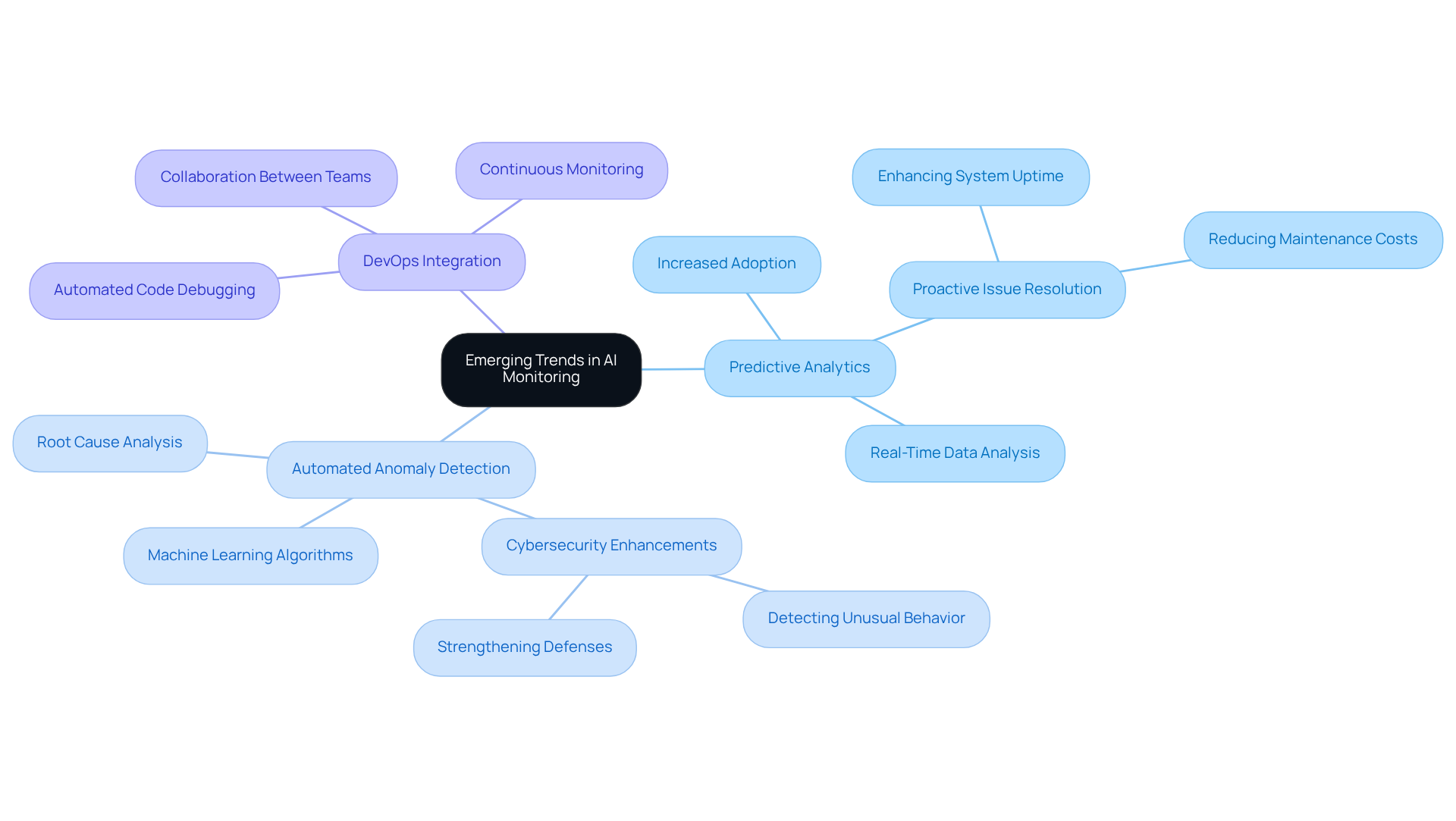
Conclusion
As the landscape of software development continues to evolve, the significance of effective AI application monitoring tools is paramount. These tools are vital for enhancing efficiency, ensuring optimal performance, and ultimately driving productivity within development teams. By integrating solutions such as Kodezi, New Relic, Fiddler, Cribl, Azure AI Foundry, and others, organizations can proactively tackle coding challenges, streamline operations, and maintain high-quality outputs.
Throughout the article, key arguments were presented, emphasizing the capabilities of each tool:
- Kodezi automates code maintenance and debugging
- New Relic offers real-time visibility
- Fiddler specializes in bug detection and resolution
- Cribl ensures continuous monitoring
- Azure optimizes resource usage
- Effective data validation methods uphold data integrity
Each of these tools contributes to a more efficient development process, enabling teams to concentrate on innovation rather than troubleshooting.
Looking ahead, the integration of these AI monitoring tools will play a pivotal role in shaping the future of software development. Organizations are encouraged to embrace these technologies, not only to enhance their current practices but also to stay ahead of emerging trends and challenges in the rapidly changing digital landscape. By investing in robust AI application monitoring solutions, teams can ensure they are equipped to meet the demands of 2025 and beyond, ultimately leading to improved outcomes and sustained competitive advantage.
Frequently Asked Questions
What is Kodezi?
Kodezi is a professional OpenAPI specification generator that automates code maintenance and includes AI application monitoring, enhancing productivity and mitigating technical debt in software development.
How does Kodezi improve productivity for developers?
Kodezi enhances productivity by detecting and resolving bugs instantly, fixing performance bottlenecks, and improving code formatting without manual intervention, which addresses code degradation issues.
What features does Kodezi offer for code management?
Kodezi offers features such as automated builds and testing, which ensure that code quality improves with every release, making it a versatile solution for developers.
How does Kodezi facilitate real-time monitoring?
Kodezi provides strong real-time insights into software functionality, enabling teams to quickly recognize and resolve problems, thus maintaining efficiency.
What impact does AI application monitoring have on performance?
Statistics suggest that adopting AI application monitoring can decrease delays by up to 58%, particularly improving supply chain efficiency.
How does Kodezi help in identifying and resolving efficiency bottlenecks?
Kodezi allows teams to resolve efficiency bottlenecks, identify security concerns, incorporate exception handling, and improve code formatting quickly within their codebase.
What is Fiddler AI Observability?
Fiddler AI Observability is a platform for AI application monitoring that automatically detects and resolves bugs within software, helping developers enhance software quality and reduce debugging time.
How does Fiddler AI Observability benefit developers?
It reduces average bug resolution times, often resolving critical issues in under 24 hours, allowing developers to focus on innovation rather than firefighting.
Why is the shift towards automated solutions important for organizations?
The shift towards automated solutions is essential for maintaining a competitive advantage and fostering a culture of continuous improvement within development teams.




